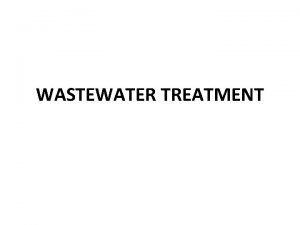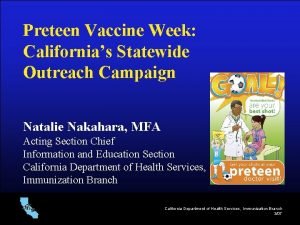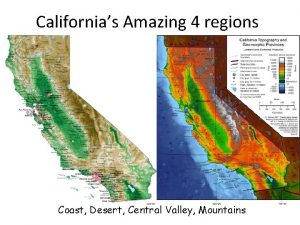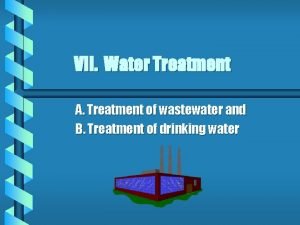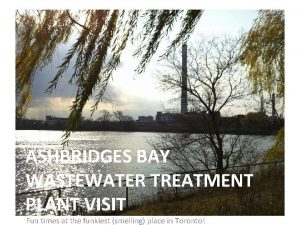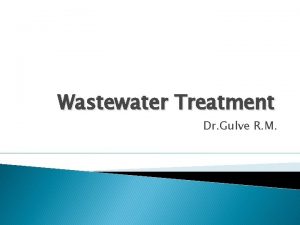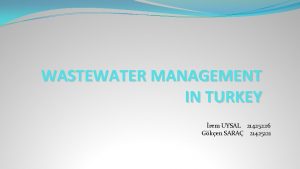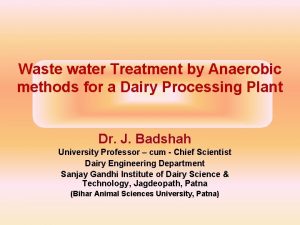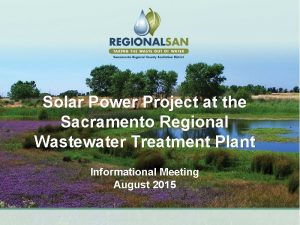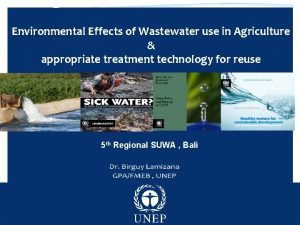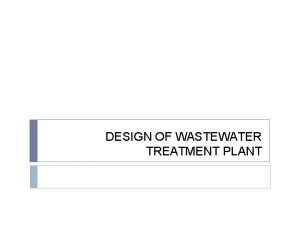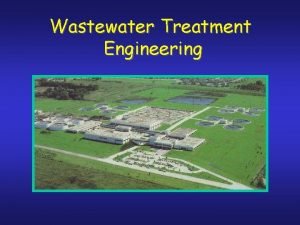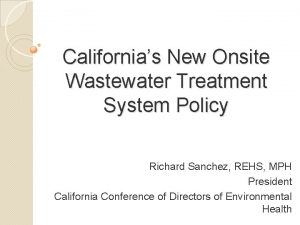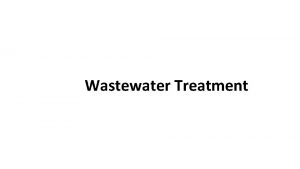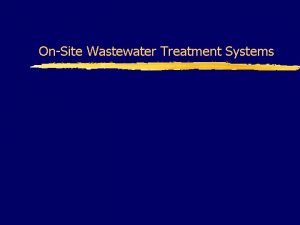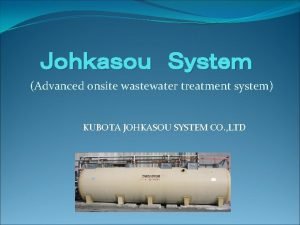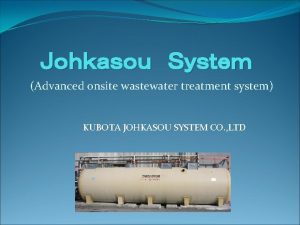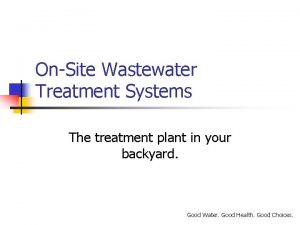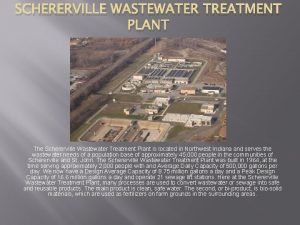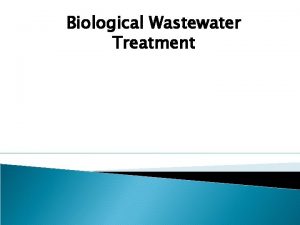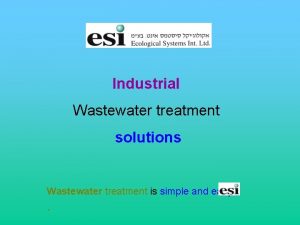Californias New Onsite Wastewater Treatment System Policy Richard












- Slides: 12

California’s New Onsite Wastewater Treatment System Policy Richard Sanchez, REHS, MPH President California Conference of Directors of Environmental Health

What are OWTS? � Small sanitary liquid waste disposal systems. � Found in areas where public sewers and treatment systems are impractical. � Efficient and effective when properly sited, designed, installed and maintained. � 1. 2 million systems located throughout the state. � Regulated by local Environmental Health, Building Depts. , Code Enforcement and Regional Water Quality Control Boards.

Why new regulations? � Some OWTS installed decades ago, when the technology was new and regulations were lacking, were improperly sited, poorly designed, and improperly maintained which has allowed wastewater to pollute surface and groundwater. � California has variable topography, soils and climate causing multiple jurisdictions to adopt a wide variety of approaches to siting and design. The new policy ensures uniform standards are met that protect water quality and public health. � California policy. was 1 of 2 states that had no uniform statewide � Technically, all OWTS should have had Waste Discharge Requirements (WDRs), but the new policy provides a

How did we get here? � AB 885 (2000, Jackson) Water Code Legislation � State Water Board directed to adopt statewide OWTS regulations by 2004. � 2 initial policy attempts met strong opposition by a variety of interested parties. � Early attempts had many unpopular prescriptive elements. � The new adopted policy is a reasonable, risk-based approach which recognizes that the current practices of the majority of responsible local agencies provide the most effective means to manage OWTS, but also improves, where necessary, existing local programs through coordination between the State and local agencies. � New Policy adopted in June 2012 with an effective date commencing May 13, 2013.

How do the new tiers work? � 5 risk-based tiers are at the heart of policy: � Tier 0 – Systems that function as designed in low-risk areas not located near impaired water bodies defined in the policy. � Tier 1 - New and replacement systems in low-risk areas not located near impaired water bodies defined in the policy. Locals bound to stringent approval criteria. � Tier 2 – New and replacement systems not located near impaired water bodies defined in the policy. Locals are approved by the state to consider more flexible permitting criteria. � Tier 3 – Existing, new and replacement systems located near impaired water bodies defined in the policy. � Tier 4 – All failing systems that require corrective action due to actual failure and/or are affecting drinking water quality or beneficial use.

Who is Impacted? � Owners ◦ ◦ � More responsibility to maintain their systems. Over 98% will have little or no impact. Under 2% might experience severe impact. Failing systems must be repaired to minimum standards. Local Governments ◦ Modified roles for current procedures plus new reporting requirements. ◦ Can choose to use the state minimum standards; or ◦ Adopt Local Agency Management Plan (LAMP) where locals have state approval to consider more flexible permitting criteria. � State Governments ◦ State Water Resources Control Board adopts and modifies policy as needed. ◦ Regional Boards must adopt changes to basin plans, define impaired waters (TMDLs), and must review local agency proposals to act as a Local Agency Management Plan (LAMP).

Tier 1 Impacts � Local Permitting Agencies must choose a tier to operate under. � Tier 1 is very stringent and basically limits a system to a septic tank, disposal field trench and a minimum lot size. � Local agencies continue to operate as usual for the first 5 years with some new minimum reporting requirements. � Owners would have to appeal to the local Regional Board if a permit cannot be approved by the local agency.

Tier 2 Impacts �Tier 2 is more flexible and recommended by the State so that local agencies can tailor approval criteria to their local land use issues. �Manpower will be needed to develop a LAMP proposal and there will be additional reporting requirements. �Owners have more options to develop properties while staying within local state approved standards.

Tier 3 Impacts � 68 local impaired water bodies located in 15 counties have been identified in the policy. � TMDLs will be adopted into each Regional Board’s Basin Plan which is a plan to limit pollutants reaching an impaired water body and to return it to its full beneficial use. � If a property is located within 600 feet of one of these water bodies, then it will be subject to Tier 3 requirements, but until a TMDL is set, any new or replacement systems will be approved under Tier 1 or Tier 2 standards. � Tier 1 and Tier 2 local agencies must implement and develop a Tier 3 Advanced Protection Management Program if they have OWTS in locations listed in the policy.

Reporting Requirements for Locals �Reporting varies by tier. �Tier 1 and 2 require local agencies to submit listings of new and replacement OWTS, complaints and actions against OWTS, and permit information about local pumper truck operators. �Tier 2 reporting adds water quality monitoring data from various sources. �Tier 3 reporting adds results of periodic effluent testing, inspection results, and maintenance schedules for specific systems that require advanced water treatment.

Timeline The effective date starts when the new policy clears the State Administrative Law Office. YEAR 1 2 -3 4 5 9 DEADLINES AFTER EFFECTIVE DATE BEGINNING MAY 13, 2013: • Regional Boards amend their Basin Plans to align with policy. • Regional Boards start developing TMDLs per the policy. • Local agencies develop and submit LAMP proposals. • Local agencies send 1 st Annual Report, annually thereafter. • Regional Boards approve/deny LAMP proposals. • Owners with existing systems in designated impaired water bodies listed in the policy may enter into legal agreements to connect to sewer to obtain some Tier 3 exemptions. • Local agencies send first 5 -year Assessment Report. • State Board renews Waiver, every 5 th year thereafter. • Owners with legal agreements must be connected to sewer.

Action � Monitor amendments to your Regional Boards’ Basin Plan to determine specific impacts to local areas, especially impaired water bodies as defined in the policy. � Determine if local permitting agencies are aware of the new policy and are preparing how to operate under the new policy. � Review local policies and ordinances to determine if changes are needed to align with the new state policy. � Determine financial impacts and plan for pathways for owners to pay for upgrades, such as hooking up to sewers if available or low cost loans, etc. (<2% of owners will be severely impacted).
 Aquaculture water treataent factory
Aquaculture water treataent factory Grade californias vaccine
Grade californias vaccine California desert region
California desert region Purpose of wastewater treatment
Purpose of wastewater treatment Wastewater treatment process primary secondary tertiary
Wastewater treatment process primary secondary tertiary Ashbridges bay water treatment plant
Ashbridges bay water treatment plant Municipal wastewater treatment
Municipal wastewater treatment Agricultural wastewater treatment technologies
Agricultural wastewater treatment technologies Anaerobic wastewater treatment
Anaerobic wastewater treatment Sacramento regional wastewater treatment plant
Sacramento regional wastewater treatment plant Agricultural wastewater treatment technologies
Agricultural wastewater treatment technologies Rectangular clarifier design
Rectangular clarifier design Secondary wastewater treatment
Secondary wastewater treatment
